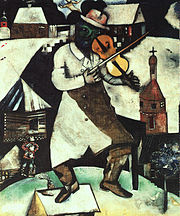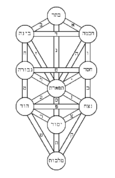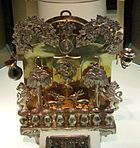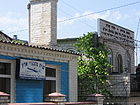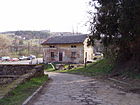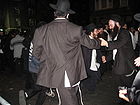- Devekut
-
Devekut, deveikuth or deveikus (Heb. דבקות , Mod. Heb. "dedication", traditionally "clinging on" to God) is a Jewish concept referring to closeness to God. It may refer to a deep, trance-like meditative state attained during Jewish prayer, Torah study, or when performing the 613 mitzvot (the "commandments"). It is particularly associated with the Jewish mystical tradition.
Contents
Etymology
The Hebrew word for glue is דבק devek which is the root for devekut, "dvekut" or devekus. The concept of Devekut is important in Jewish culture, particularly in Hasidism and in the history of Jewish thought, mysticism, and ethics.
In modern Israeli Hebrew, "Devekut" or "dvekut" is often a synonym for dedication toward a particular goal.
In religious Judaism and in academia, "Dvekut" refers most commonly to the philosophical, mystical and Hasidic understanding of "Devekut" as "cleaving" or "attaching oneself" to God in all areas of life.
Devekut in Kabbalah
 The view from Safed. The great Kabbalists of 16th century Safed would welcome the Divine feminine Sabbath Bride in the fields at Friday dusk
The view from Safed. The great Kabbalists of 16th century Safed would welcome the Divine feminine Sabbath Bride in the fields at Friday dusk See also: Kabbalah
See also: KabbalahIn Kabbalah, close circles of elite scholars would seek elevated mystical states of devekut, often through ascetic practices.
Until its communal popularisation and psychological internalisation in Hasidism in the 18th century, Jewish mystical study and practice was confined to close circles of elite scholars. Medieval Kabbalists often adhered to ethical and ascetic practices, such as among the Chassidei Ashkenaz of the 12th-13th century. They sought elevated mystical states as part of their endeavours in Kabbalah Iyunnit ("Conceptual Kabbalistic" investigation). They sought an esoteric, transcendent scholarship in Scriptural exegesis, that involved subtle metaphysical descriptions of Divine emanations and Heavenly Realms. Their elite schools had an influence on wider Jewish thought, with Kabbalah and Hakirah (Medieval Rationalistic Jewish philosophy) emerging as the two competing traditions of Jewish theology. After the Expulsion from Spain in the 15th century, Kabbalah replaced Hakirah as the mainstream theology of Judaism, both in scholarly circles and in the popular imagination. It was perceived that widespread following of Hakirah had not encouraged sections of Spanish Jewry from assimilating as Marranos, when threatened with the expulsion. Meanwhile, Kabbalah received great revival among the emergent leading mystic community of 16th century Safed in Israel, that comprised great Rabbinic figures from Spain. The mainstream Rabbinic scholarship of this community, including the mystic and halachic compiler of the Shulchan Aruch, Yosef Karo, attested to the centrality of Kabbalah as the mainstream Jewish theology. This school produced the new, successive descriptions of Kabbalistic synthesis by Moshe Cordovero and Isaac Luria. One of the mystical practices of dveikut of this close circle was its self-sacrifice in devotion as brethren among its members, which involved self-effacing love and tzedakah between them.
Alongside its historical advances in Conceptual Kabbalistic interpretation, the leaders of the community composed Sabbath hymns that entered Jewish liturgy. The most famous is Lekhah Dodi, composed by Shlomo Halevi Alkabetz, which welcomes the Shechinah (Feminine Divine Presence) as a Shabbat Queen. The mystics, including Isaac Luria in his brief two years in Safed, would go into the fields around Safed at dusk on Friday, to welcome the Shabbat in elevated dveikut:
Come in peace, crown of Her husband
Both in happiness, in song and in jubilation
Amidst the faithful of the treasured nation
Come O Bride! Come O Bride!
Amidst the faithful of the treasured nation
Come O Bride! Shabbat Queen!
Boi ve-shalom ateret ba'alah
Gam be-simchah be-rina u-ve-tzahalah
Toch emunei am segulah
Bo-i chalah boi chalah
Toch emunei am segulah
Bo-i chalah Shabbat malketaBefore the establishment of this elite community in Safed, its members recounted a historic mystical episode they experienced, in which they received a Heavenly voice. Following the practice described in the Zohar, the circle stayed up on Shavuot night. During the recitation of the required texts, the Shekhinah appeared as a maggid presence to Rabbi Karo praising the circle and telling them to move to the Land of Israel. When they stayed up again the second night of Shavuot, the Shechinah was adamant about their moving to the land of Israel. The account, recorded by Alkabetz, is quoted in the article Shlomo Halevi Alkabetz. In Jewish mystical interpretation, the National turmoil of the recent expulsion from Spain, and its subsequent persecutions of remaining Jewry led to the new mystical endeavours of the Safed Kabbalists, and their sensitivity to the distress of the Shechinah in Her exile. Kabbalistic teaching describes the Shechina going into mystical exile alongside the Jewish people in the journeys of their physical exile.
The path in dveikut of historical Kabbalah, both in its first Medieval dissemination, and in its 16th century Renaissance, was dependent on many conditions. Kabbalistic thought was limited to more advanced scholars. This was both a historical tradition, and an inherent characteristic. The form of historical Kabbalah embodied in its texts required extensive understanding of mainstream Rabbinic texts, in order to correctly understand its subtle metaphors, and to avoid their anthropomorphism. This danger was subsequently born out in the heretical misinterpretations of Kabbalah by the Sabbateans and their successors. With advanced understanding, the dveikut was allied with ascetic practices, as grasp of Kabbalistic thought was seen to involve spiritual preparation for the intuitive illumination within its structures. While surface reading of Kabbalistic texts was viewed as a Divine blessing, the Oral Torah chain of tradition and scholarship required an authentic fidelity. The transcendent nature of historical Kabbalah, that focused on emanations of God in the Heavenly Realms, meant that its expression in dveikut was a similar response to Divine transcendence.
Devekut in Hasidism
See also: Hasidic philosophyIn The Earth is the Lord's: The Inner World of the Jew in Eastern Europe,[1] Abraham Joshua Heschel evokes the world of Eastern European Jewish life. He interprets it as a supreme expression of the Jewish spirit
 Hasidic born Elie Wiesel adapts Hasidic deveikut in literary expression. His Hasidic portraits, memoirs and theological novels investigate a personal mysticism of silence[2]
Hasidic born Elie Wiesel adapts Hasidic deveikut in literary expression. His Hasidic portraits, memoirs and theological novels investigate a personal mysticism of silence[2]
The Hasidic movement, that began in 18th Century Eastern Europe, brought a mystical revival and the first popularisation of Jewish mysticism for the masses. Hasidism adapts historical Kabbalistic thought in its own characteristic ways, and can be seen as a successive stage of the Jewish mystical tradition.[3] This democratisation of mysticism for everyone involved both outer expressions in fervour, and inner depths in Kabbalistic interpretation. Outwardly, the Baal Shem Tov, founder of Hasidism, awakened popular mystical joy and dveikut, appreciation of sincerity, new emphasis on prayer, and cherished encouragement of simple folk. The new doctrine of the Hasidic Rebbe, embodied in charismatic hagiographic storytelling, personified Divinity for the common folk. Hasidic philosophy articulated an internalisation of the esoteric structures in historical Kabbalah, so that they could awaken new dimensions of spirituality for both the elite scholars and the simple laypeople. This related Kabbalistic metaphysics to its corresponding faculties in natural psychological perception.[3] While the focus of historical Kabbalah was on transcendent Divine emanations through the descending Chain of Worlds, the focus in Hasidic philosophy was the essential Divine Omnipresence expressed immanently, intimately accessible to each person. The simple, unlettered folk could reach this directly through their heartfelt sincerity, while elite scholars were attracted to Hasidism as they saw in its thought a new soulful dimension to previous Rabbinic and Kabbalistic interpretation.
In terms of the history of Jewish mysticism, Kabbalah has been called the "soul of the Torah", describing its esoteric dimensions, while Hasidism has been called the "soul of the soul", looking to the inner Divinity within everything.[3] While the expression of dveikut in transcendent Kabbalah was related through transcendent experience, dveikut in immanent Hasidic Divinity was related through essential inward experience. This was accessible to the whole community, as Hasidism emphasised the superior qualities of both the simple folk and the scholars. With its emphasis on Divine Omnipresence, Hasidic philosophy sought to unify all aspects of spiritual and material life, to reveal their inner Divinity. Dveikut was therefore achieved not through ascetic practices that "broke" the material, but by sublimating materialism into Divine worship. Nonetheless, privately, many Hasidic Rebbes engaged in ascetic practices, in Hasidic thought for mystical reasons of bringing merit to the generation, rather than formerly as methods of personal elevation. The Baal Shem Tov taught of the superior advantage in Jewish service, of incorporating materialism within spirituality. In Hasidic thought, this was possible because of the essential Divine inspiration within Hasidic expression. In its terminology, it takes a higher Divine source to unify lower expressions of the material and the spiritual. In relation to the Omnipresent Divine essence, the transcendent emanations described in historical Kabbalah are external. This corresponds to the Kabbalistic difference between the Ohr (Light) and the MaOhr (Luminary). Essential Divinity permeates all equally, from the common folk to the scholars.
Love of God, Awe of God, and nullification of the ego in Hasidism
Hasidus and Mussar
Further information: Hasidism, Musar literature, and Musar movementTraditional Jewish philosophical, ethical and mystical thought describes the two fundamental emotions in spiritual devotion, of "love of God" and "fear/awe of God". Hasidic thought gives these standard notions its own interpretations. The founder of Hasidism, the Baal Shem Tov, opposed the ethical practices of admonishment (see Maggid), that could interpret fear of God as fear of punishment. In Hasidism such fear is seen as superficial, egotistical and misrepresentative of the Divine love for Creation. Hasidism sought to replace Jewish observance based on self awareness with an overriding perception and joy of the omnipresent Divine (see Divine immanence). It likewise reinterpreted the traditional Jewish notion of humility. To the Hasidic Masters, humility did not mean thinking little of oneself, a commendable quality that derives from an external origin in Jewish spirituality, but rather losing all sense of ego entirely (bittul-the negation of ego). This inner psychological spirituality could only be achieved by beginning from the inside, through understanding and awareness of Divinity in Hasidic philosophy. The Hasidic leaders say that "to dispel darkness (spiritual impurity and obstacles), one does not fight it", the method of Mussar, as such success has the drawback of immersing oneself in the problems.[citation needed] Rather, "one turns on the light", as "a little bit of light gets rid of a lot of darkness". The light represents the illumination in the psyche of Hasidic thought.
The great Masters of Mussar would counter that such a path has the danger of escapism, as understanding oneself is the basis of mature consciousness.[citation needed] In some Hasidic schools, this pitfall of mystical escapism is avoided. In Habad Hasidism, for example, Jewish meditation differed from "General Hasidism" in seeking intellectual understanding and inward contemplation over more external forms of emotional enthusiasm.
Negation of ego and self sacrifice for another person
See also: Ohr The Baal Shem Tov taught the value of both laymen and scholars. In a parable, the Tzadik's prayers are like standing on shoulders to reach a high bird. The people give the Rebbe mystical abilities. The Rebbe lives for the followers
The Baal Shem Tov taught the value of both laymen and scholars. In a parable, the Tzadik's prayers are like standing on shoulders to reach a high bird. The people give the Rebbe mystical abilities. The Rebbe lives for the followers
Across all Hasidism the continual mystical joy and bittul-humility "between man and God", is ideally reflected likewise in self sacrifice to help another person "between man and man". In Jewish law, self sacrifice is called "mesiras nefesh", and involves the occasional situations when one forfeits life. In daily terminology in Hasidism, mesiras nefesh means instead devoted sacrifice for God or another person. It is indicative of this that the two Hasidic schools most focused on daily learning of Hasidic thought, Habad (Lubavitch) and Breslav, have also become the two schools involved in the Baal Teshuva movement. In Habad, the talented young men and women devote themselves to going on Shlichus (outreach), rather than the traditional and commendable devotion to Torah study and personal spiritual advancement. In Habad thought, such material and spiritual help for another person achieves its own manifold spiritual illumination and refinement of one's personality. Just as some traditional forms of Jewish thought gave emphasis to fear of punishment as a helpful contribution to beginning Jewish observance, before progressing to more mature levels, so too do some Jewish approaches advocate motivation from eternal reward in the Hereafter, or the more refined ideal of seeking spiritual and scholarly self-advancement through Torah study. Study of Torah is seen by Rabbinic Judaism as the pre-eminent spiritual activity, as it leads to all other mitzvot (Jewish observances). To seek personal spiritual advancement through learning is a commendable ideal of Rabbinic Judaism.
Hasidism, ideally, rejected the focus on spiritual reward, or ultimately also the ideal of spiritual self advancement, as too self centred. Before the magnificent awareness of Divine majesty, through the mystical path, the automatic response is sincerity and a desire to nullify oneself in the Divine presence. The Habad Shaliach, for example, who moves to a remote place to offer Jewish life there, generally absorbs the notion that it is worthwhile to reject even refined levels of self-centred spiritual advancement, from advanced Yeshiva study, to help another person in their spiritual and physical needs. This attitude has also spread in recent times to non-Hasidic Lithuanian Jewish Orthodoxy, as part of the spiritual campaign of the Baal Teshuvah movement.
Traditionally, part of the early opposition of the Talmudic focused Mitnagdim, centred in Lithuania, was their fear that Hasidism demoted the traditional importance on Torah study, from its pre-eminent status in Jewish life. Some Hasidic interpretations saw mystical prayer as the highest activity, but their practitioners thought that through this, all their Jewish study and worship would become more spiritualised. By the mid-19th Century, the schism between the two interpretations of Eastern European Judaism had mostly healed, as Hasidism revealed its dedication to Talmudic scholarship, and the Lithuanian World saw advantages in ethical focus.
Hasidic anecdotes illustrate its mystical idea of rejecting notions of reward and punishment in favour of bittul (nullification) of the ego and devoted self-sacrifice. In one account:
The first leader of Habad Schneur Zalman of Liadi kept in his desk some of his unpublished Hasidic mystical writings. A fire broke out that destroyed them. Afterwards, he asked if anyone had secretly copied them. His close associates replied that no one had, since he had written atop their pages the warning of "a mystical cutting off of one's soul in the next World for anyone who copies these manuscripts". It seems that Schneur Zalman felt that he had not been given permission to distribute these teachings from Heaven. In response to their answer, he replied "what has become of Hasidic self-sacrifice for the sake of Heaven?"!
Forms of love and fear of God
The "love of God" and "fear of God" receive different interpretations across the historic texts of Judaism, from their different appellations in the Song of Songs, through the Talmud, Medieval Jewish Philosophers, Musar literature and the Kabbalah. To Maimonides, for example, based on the synthesis of Jewish revelation with Greek philosophy, love and fear were to be awakened by contemplating the wonders of Creation, which could reveal the presence of their Creator. Hasidism adopts the Kabbalistic interpretations of the different forms of love, and the mystical interpretations of fear as awe before the Divine majesty. Basing itself on the Kabbalistic explanations of the terminology in the Song of Songs, the classic Hasidic manual for serving God, the Tanya by Schneur Zalman of Liadi, describes many types of mystical love and awe. The methods of Jewish meditation advocated here are particular to the Habad school of thought, but this text is revered across general Hasidism, as being a systematically structured guide to daily Hasidic life. In all Hasidism, as in Kabbalah, love and awe are awakened by study of mystical texts, in Hasidism of Hasidic philosophy, and in the varying ways of the different schools within Hasidism of applying this in daily Jewish life. Based on Kabbalah, it differentiates between lower and higher forms of love, awe and nullification of the ego.
Love of God and spiritual reward
The soulful advantage of Hasidism over Kabbalah is expressed in its ability to be expressed without recourse to the esoteric terms of Kabbalah. This is brought out most in the charismatic spiritual stories told about the beloved Masters of Hasidism, as well as in the mystical parables they told to illustrate ideas. One such parable differentiates between superficial forms of love of God and spiritual reward, with true forms of selfless love:
A powerful King was grateful to two simple poor people for their devotion, and decided to show his gratitude. The poor labourers had never been into the palace before, but had only seen the King at state occasions. After receiving their invitations to see the King, in trepidation and excitement, they approached the palace. As they entered, they were amazed to behold the magnificence of the palace. One servant was so enamoured of these riches, that he stopped in the great halls to delight in their beauty. He never progressed beyond these chambers. Meanwhile, the other servant was wiser, and his desire was only for the King. The beautiful ornaments did not distract him, as he entered the inner chamber, where he delighted in beholding the King himself.
Likewise a story is told of how in moments of mystical rapture, Schneur Zalman of Liadi would be seen rolling on the floor, exclaiming "God, I don't want your Garden of Eden (Heavenly World), I don't want your World-to-Come (Messianic days), I just want You!".
The psychological experience of devekut
The teachers of Hasidism point out that fear of God is different from natural forms of worldly fear, which are uncomfortable experiences, and when experienced, at the time remove other emotions. The awe and trepidation felt when perceiving the mystical greatness of God carries its own delight and bittul-nullification, and can be felt together with longing and delight of mystical love.
The natural experience of Nature, and the mystical experience of Nature
 Hasidic stories recount the travels of Tzadikim Nistarim (hidden Tzadikim) and Hasidic Rebbes among the Shtetls and countryside of Eastern Europe
Hasidic stories recount the travels of Tzadikim Nistarim (hidden Tzadikim) and Hasidic Rebbes among the Shtetls and countryside of Eastern Europe
For one who has studied the texts of Hasidism, and has responded to their "Wellspings",[4] they can then carry this mystical perspective into daily life. Especially opportune, in traditional Hasidic life, was seeking times of solitude amongst Nature. In Breslov Hasidism, the simple prayers of one's heart in such a setting (Hitbodedut) becomes of central importance. Rabbi Nachman of Breslav poetically depicts the spiritual lifeforce in the grasses of the field as joining and helping in one's prayers. Psychologically too, the aesthetic beauty of Nature becomes elevated by seeing the Divine transcendence reflected in it. To a sensitised soul, a tree can take on the extra dimension of a mystical beauty, that unites the Divine immanence of God with the transcendence. Divine transcendence and immanence are traditional notions in Jewish thought. The Panentheism of the Baal Shem Tov gave new emphasis on the theology and perception of the immanent Divine in all things. This carried earlier Kabbalistic notions, that saw Nature as a manifestation of God, to their theological conclusions. (The Kabbalists explain that one of the Hebrew names of God "Elo-h-im", representing Divine immanence, is numerically equivalent in Gematria with "HaTeva" meaning "Nature"). In the second section of the Tanya, Schneur Zalman of Liadi articulated the philosophical explanations of this. Similarly, the Baal Shem Tov gave a new interpretation of Divine Providence, that described how the movement of a leaf in the wind is significant in the Divine plan. A tale of the Baal Shem Tov also depicts the relationship between consciousness of the Divine immanence in Nature, infused with the higher light of Divine transcendence:
Once, when the Baal Shem Tov was on a journey, Sabbath overtook him on the highway. He stopped the wagon, and went out into the field to perform the services that welcome the coming of Sabbath, and to remain there until the Sabbath was ended. On the field, a flock of sheep were grazing. When the Baal Shem Tov raised his voice and spoke the prayers that welcome the Sabbath as the coming of a Bride, the sheep rose upon their hind legs, and lifted their heads in the air, and stood like people listening. And so they remained in wrapt attention for two hours, all the while that the Baal Shem spoke.[5]
In the tale, the sheep become aware in their instinctive feelings of the existence of a Divine transcendent reality. According to the tale, the Baal shem Tov's prayers could be holy enough for even instinctive creatures to perceive this.
Deveikut and Jewish observance
Deveikut in cleaving to the Tzadik
The early Hasidic movement around the Baal Shem Tov developed from elite esoteric mystical circles of pneumatics,[6] sometimes connected in practical fellowship. True Deveikut in early Hasidism reflected the superior nature of elevated mystical conduct, beyond the attainment of the regular community, though reaching out to encourage the common folk through popular mystical teaching. With the development of Hasidism as a large scale social movement through the disciples of Dovber of Mezeritch, the doctrine of Mainstream Hasidic "Popular Tzadikism" developed, especially by Elimelech of Lizhensk. In this, while true deveikut was unattainable by the common folk through their own efforts, the substitution of attachment, sometimes called "Deveikut", to the Tzadik enabled everyone to perceive and experience Divinity.[7] This was the first time that Jewish mysticism, embodied in the elite esoteric deveikut of the Tzadik, was combined with practical, popular social doctrine and movement. Tzadikism, and its parallel worship of God through materiality, became the most distinctive feature of Hasidic Judaism, distinguishing Hasidism from other forms of traditional Judaism. The Tzadik embodied Divinity, through Hasidism's adaption of the Kabbalistic notion of Yesod-Foundation, becoming the channel of Divine spiritual and physical blessing to his followers. The Russian Chabad school of Shneur Zalman of Liadi and his successors became the exception from Mainstream Hasidism, in seeking to communicate the elite esoteric dimension of deveikut as widely as possible, through its approach of intellectual investigation of Hasidic thought.[8] In this, as in the different Polish Peshischa-Kotzk school that stressed personal autonomy, the main role of the Tzadik was as teacher in Habad, or mentor in Peshischa. The most extreme form of Mainstream Tzadikism, sometimes opposed by other Hasidic leaders, was embodied in "Wonder-working" Rebbes, for whom Divine channelling of blessing through theurgic practice became central, at the expense of Torah teaching. Hasidism developed the customs of Tish (gathering), Kvitel (request) and Yechidut (private audience) in the conduct of the Tzadik.
Deveikut and Teshuvah
Repentance in Judaism Teshuva "Return"Repentance, atonement and
higher ascent in JudaismIn the Hebrew Bible 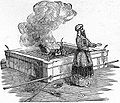
Altars · Korban
Temple in Jerusalem
Prophecy within the TempleAspects 


Confession · Atonement
Love of God · Awe of God
Mystical approach
Ethical approach
Meditation · Services
Torah study
Tzedakah · MitzvotIn the Jewish calendar 


Month of Elul · Selichot
Rosh Hashanah
Shofar · Tashlikh
Ten Days of Repentance
Kapparot · Mikveh
Yom Kippur
Sukkot · Simchat Torah
Ta'anit · Tisha B'Av
Passover · The Omer
ShavuotIn contemporary Judaism Baal Teshuva movement
Jewish RenewalSee also: Teshuvah and Divine providence (Judaism)Teshuvah, often translated into English as "Repentance", literally means "Return" to God in Judaism. Halachic codes identify its defining stages in personal spiritual repentance and atonement from sin. Musar literature generally see its role in broader self-understanding, spiritual growth, and personal fidelity. Hasidic thought, based upon Kabbalistic exegesis, gives it a mystical ascending structure. It interprets two levels of return, "Lower Teshuvah" (Lower Return to God), and "Higher Teshuvah" (Higher Return). In Hasidic philosophy,[9] Teshuvah does not only involve repentance and rectification of previous spiritual faults. Rather, as the Baal Shem Tov taught, even perfectly righteous Tzadikim need to return to God, in the higher Teshuvah of continual ascent in holiness. With new revelations of mystical Divinity, come new awareness of Bittul (self-nullification) and desire for God in Deveikut. According to Kabbalistic exegesis of the Hebrew word "Teshuvah" (תשובה), it can be read as "Returning the letter hei" (תשוב-ה). The Tetragrammaton essential Divine name has two letters "hei", the second one corresponding to the lower revealed levels of the Four Worlds in Kabbalah, and the first one corresponding to the higher concealed realms. Spiritual lapses by man only reach the lower realms. Lower teshuvah returns the second hei in rectification, higher teshuvah redeems the higher hei in holy ascent.
The service of the Hasidic Rebbe Tzadik is continual ascent in dveikut of love, awe and faith of God. This is called the service of "Eschapchah" ("Transformation" of darkness to light). The regular folk who rise and fall spiritually, engage more in the service of "Iskafiah" ("Subjugation" of impurity). With its characteristic articulation of Divine Omnipresence in everything, Hasidism emphasises the superior quality of both services. Stories are told of Hasidic Rebbes who envied the battle with impurity of the common folk. When a person falls spiritually, and is in need of "Lower Teshuvah", then Hasidic thought gives encouragement in their new reality. Talmudic theology describes its own two types of Teshuvah, "Teshuvah from Fear" of God, which erases sin, and "Teshuvah from Love" of God, which transforms sin into merit. In the path of Hasidic rectification of sin, through mystical dveikut the sin can be transformed (Eschapchah) into full inner merit. Once the Hasidic follower perceives their inner exile from God that sin caused, through mystical study they become awakened to an even stronger desire for God than the Tzadik can reach. This is compared to the thirst of a person in a dry desert without water. With devoted dveikut they can become a fully transformed person, and the route to their superior Divine level was through the sin itself. Accordingly, the Baal Shem Tov interpreted the Hebrew word for sin (חטא-"Cheit") as possessing a silent letter Aleph at the end. This represents, he said, the concealed spark of holiness within the sin itself, that is revealed in Teshuvah.
The Hasidic Rebbe Nachman of Breslov inspires a search for deveikut in distanced Jews. The annual Rosh Hashana kibbutz pilgrimage to his grave in Uman Ukraine, attracts many secular seekers of spirituality
Kabbalah describes this process as "every spiritual descent is only in order to reach an even higher subsequent ascent". In Hasidic Omnopresence, the Baal Shem Tov taught a new view of individual Divine Providence. In this every detail is a concealed part of the Divine plan. Each individual is destined to personally redeem their personal sparks of holiness. In Hasidism, therefore, the spiritual failure is itself the concealed inner beginning of the ultimate ascent.
In Hasidic lore, the path of Nachman of Breslov is especially related to giving redemption and encouragement to those people who are caught up in personal difficulties and spiritual impurity. Through his creative articulation of Hasidic mysticism, his teachings can awaken a desire for deveikut, the path of personal hitbodedut expression of one's problems, and a mystical Tikkun HaKlali rectification for all. His main work Lkkutei Moharan is colloquially referred to as the Hasidic book to help those in spiritual difficulties ("wickedness"). The Tanya of Schneur Zalman of Liadi is subtitled the "Hasidic book for the intermediate person" who has ease to intellectually meditate on Hasidic philosophy to reach inner Teshuvah. The work Noam Elimelech by Elimelech of Lizhensk instructs the "Hasidic book for the righteous", and the Mainstream Hasidic path of Teshuvah through cleaving to the Tzadik.
Deveikut and Hasidic prayer
See also: Jewish meditationThe Baal Shem Tov taught the spiritual value of simple Jewish folk. This was at a time after the 17th century Khmelnytsky Uprising had devastated Jewish communities in the Ukraine, and a gap had evolved between the centres of Talmudic scholarship and the unlettered masses. With the traditional preeminence in Rabbinic Judaism on Torah study, it was perceived that the unlettered masses, though not at fault, were spiritually inferior. Maggidim toured Jewish communities offering admonishment of further punishment as a means of encouraging Jewish observance among the disenfranchised masses. In this arena, the Baal Shem Tov's mysticism taught that the sincere common folk could be closer to God than a scholar who has self-pride in his accomplishments. He conveyed his revolutionary ideas in parables, stories and terse teachings among the market places of the populace. The legendary tales about him, later copied in Shivchei HaBesht and other hagiographic compilations describe how much he cherished the sincere prayers of the simple, artless folk. In perhaps the most characteristic Hasidic story, the Baal Shem Tov's conduct instructed his new mystical teaching and boundless delight in the unlettered deveikut of the simple folk:
The saintly prayers of the Baal Shem Tov and his close circle were unable to lift a harsh Heavenly decree they perceived one Rosh Hashanah (New Year). After extending the prayers beyond their time, the danger remained. An unlettered shepherd boy entered and was deeply envious of those who could read the holy day's prayers. He said to God "I don't know how to pray, but I can make the noises of the animals of the field." With great feeling, he cried out, "Cock-a-doodle-do. God have mercy!" Immediately, joy overcame the Baal Shem Tov, and he hurried to finish the day's prayers. Afterwards, he explained that the heartfelt prayer of the shepherd boy opened the Gates of Heaven, and the decree was lifted.
Through this emphasis, Hasidism popularised Jewish mysticism. It offered deveikut, that had previously been restricted in transcendent Kabbalistic forms, in new tangible, direct immanent perception. Later Hasidic paths adopted different methods in Jewish meditation for prayer, from the Breslov fostering of emotional Hitbodedut ("secluded" prayer), to Chabad intellectual Hitbonenut ("Contemplative" prayer).
Musical expression of Deveikut in Niggunim
Main article: NigunA revival of interest in Jewish music was sparked as part of Hasidism. Hasidic niggunim melodies are a distinctive form of voice instrumental music, expressing its mystical emotions of deveikut. Hasidism gave new emphasis to song as a form of worship in prayer. As many niggunim are without words, it is taught that the niggun can reach spiritual levels higher than the words of prayer can reach, as they open the heart to love and awe of God. As many niggunim were composed by Hasidic Masters, it is thought that through singing their melodies, the follower can be attached and inspired by the soul of their Rebbe. This musical dimension of Hasidic deveikut, similar to the new forms of worship in Hasidic storytelling, captures the characteristics of its mystical ecstasy.
Different Hasidic groups evolved their own distinctive styles of niggun. Followers customarily gather around on Jewish holidays to sing in groups, receive and give spiritual inspiration, and celebrate brotherly camaraderie. Hasidic custom venerated pilgrimage to the particular Rebbe one had allegiance to, either to gain a private audience or to attend their public gatherings (Tish/Farbrengen). The celebrations give over his Torah teachings, sometimes personal messages, and are interspersed with inspirational niggunim.
There are nigunim for private meditation, often in prayer, called devekus nigunim. These are usually slower than communal nigunim, and without lyrics. The Baal Shem Tov spoke of devekus nigunim as "songs that transcend syllables and sound". Several tunes attributed to him are still used today.
Some niggunim originate from non-Jewish sources. Hasidic custom, based on a practice of the Baal Shem Tov, adapted secular anthems, marches and folk songs, ascribing to them a new spiritual interpretation. Hasidic belief is that these songs, in their secular forms, are in spiritual exile. By adapting them to liturgical forms, they are raising "Sparks of Holiness", based on the Kabbalistic rectification of Isaac Luria.
On Jewish festivals, such as in the intermediate days of Sukkot and during the traditional celebration of Simchat Torah, the most joyous day in the Jewish calendar, joyful niggunim are sung in the dancing in the synagogue.
Deveikut and Mitzvot
See also: MitzvotThere is a historical debate in Rabbinic literature as to whether Torah study or Mitzvot (Jewish observances) are spiritually superior. The 613 Mitzvot themselves are able to be divided into ethical ("between man and man") and ritual ("between man and God") observances. Mystical literature, based on Kabbalah, gives its own metaphysical reasons for the mitzvot. Hasidism arose at a time when advanced Talmudic study was seen as the supreme Jewish activity, yet was out of reach of the unlettered masses. The Baal Shem Tov gave new prominence to prayer and sincere observance of the mitzvot by the artless common folk. To the Baal Shem Tov, "God desires the heart".[10] Just as the simple prayers of the common masses could reach beyond the self-aware spirituality of scholars, so too, their mitzvot could also reach spiritual levels that the Tzadikim envyed and emulated.
In the profound dimension of Hasidic philosophical interpretation of Kabbalah, the mitzvot are described as the metaphorical "limbs of the King" (God) and an embrace of the Divine essence expressed within the Will of the commandments. Hasidic tales are told of the deveikut of Rebbes and simple Jewish folk in their fulfilment of the mitzvot. Many tales are related of the fervour of Levi Yitzchok of Berditchev, called the "Heavenly Advocate of Israel" before God. His saintly emotional response to deveikut would break restrained rules of conduct, sometimes humorously in public. In one story, he prepares himself to ritually slaughter a chicken according to the halachic laws of shechita:
As he recited the blessing prior to the act, he dwelt on the holy commandment he was about to perform. "Blessed art Thou, God..", he began. "..Who commands us concerning Shechita", he concluded in such fervour that he lost all sense of his surroundings. Opening his eyes after the blessing, he looked around to find an empty room, with the chicken escaped. "Where is the chicken" he began asking!
-
A Hasidic aphorism advises lighting a fire, rather than donning a fur coat to warm up; analogous to its aims of popularising mysticism, encouragement over admonishment, and rejection of asceticism
-
Hasidism comprises both elite contemplation of God, and popular deveikut to the Tzadik. The doctrine of "Popular Tzadikism" innovated social institution in Jewish mysticism[13]
-
Hasidic mysticism idealises material outcome for Divinity. The role it gives communal gathering and song over traditional added study, is to seek to open receptivity and self-accounting
See also
Jewish mysticism:
Practices:
- Jewish meditation
- Jewish prayer
- Mitzvot
- Niggun
- Teshuvah
- Tzedakah
Concepts:
- Awe of God
- Ayin and Yesh
- Inner dimensions of the Sephirot
- Jewish theology of love
- Love of God
- Ohr
References
- ^ Jewish Lights Publishing
- ^ Annotated Bibliography of Books by Elie WieselStory and Silence: Transcendence in the Work of Elie Wiesel
- ^ a b c Ginsburgh, Yitzchak. Overview of Chassidut from www.inner.org
- ^ The Baal Shem Tov's "Torah", the new teachings of Hasidism, is traditionally called his "Wellsprings". In the famous mystical account he related in a letter to his brother-in-law Abraham Gershon of Kitov, in which he describes the ascent of his soul to the Heavenly realms on Rosh Hashanah of the year 5507 (1746), he says: "I asked the Mashiach, 'When will the Master come?' And he answered, 'By this you shall know: When your teachings will become public and revealed in the world, and your wellsprings burst forth to the farthest extremes..'"
- ^ From "The Golden Mountain" by Meyer Levin (1932), at sacred-texts.com [1].
- ^ A circle of pneumatics in pre-Hasidism: Article in Studies in East European Jewish Mysticism and Hasidism, Joseph Weiss, Littman Library of Jewish Civilization
- ^ God and the Tzadik as the two focal points of Hasidic worship, Ada Rapoport-Albert in Essential Papers on Hasidism, edited by Gershon David Hundert, New York University Press
- ^ Comminicating the Infinite: The emergence of the Habad school, Naftali Loewenthal, University of Chicago Press
- ^ The two levels of Teshuvah in Hasidism are defined in the third section of the Tanya. The Hasidic approach to Teshuvah began with the seminal stories, parables and teachings of the Baal Shem Tov
- ^ A Talmudic aphorism that the Baal Shem Tov put at the centre of his teaching
- ^ Neo-Hasidic Abraham Joshua Heschel said that his famous participation in the Selma to Montgomery marches felt like the pilgrimage of a Hasid to his Rebbe
- ^ Walking as a Sacred Duty: Theological Transformation of Social Reality in Early Hasidism by Elliot R Wolfson, in Hasidism Reappraised edited by Ada Rapoport-Albert. Littman
- ^ The Zaddik: The Interrelationship between religious Doctrine and Social Organization by Immanuel Etkes, in Hasidism Reappraised
Categories:- Jewish theology
- Jewish mysticism
- Hasidic thought
- Jewish prayer and ritual texts
-
Wikimedia Foundation. 2010.

